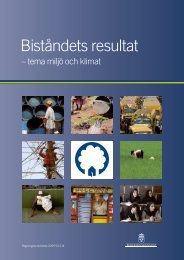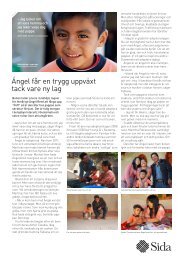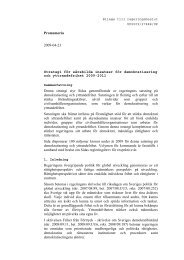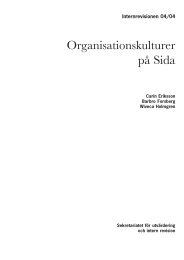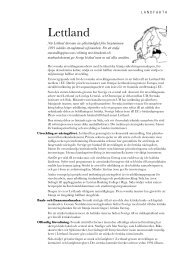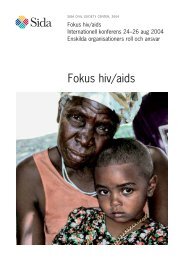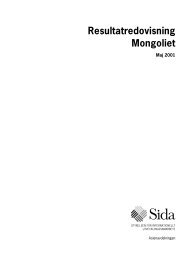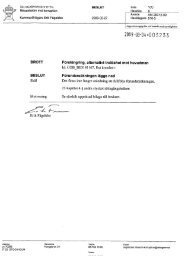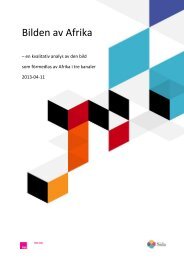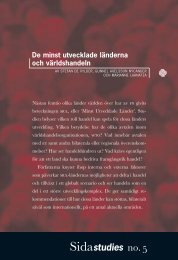Mid-Term Review of the AGIR Programme - Sida
Mid-Term Review of the AGIR Programme - Sida
Mid-Term Review of the AGIR Programme - Sida
You also want an ePaper? Increase the reach of your titles
YUMPU automatically turns print PDFs into web optimized ePapers that Google loves.
E X E C U T I V E S U M M A R Y<br />
tionalisation is still mostly done as four sub-programmes that share common<br />
areas. Therefore sub-programme consistency is better than programme consistency.<br />
Despite efforts in joint coordination, implementation and reporting<br />
(apart from <strong>the</strong> common areas), it is sometimes not clear to what extent subprogramme<br />
outcomes and results are feeding into programme impact. The<br />
mid-term review team agrees with <strong>the</strong> conclusions <strong>of</strong> <strong>the</strong> 2012 semi-annual<br />
report that, while general reporting has improved, <strong>the</strong> programme needs to<br />
start analysing how various outcomes <strong>of</strong> <strong>the</strong> <strong>the</strong>matic areas can be clustered<br />
and reported as a set <strong>of</strong> consistent programme results that clarify and streng<strong>the</strong>n<br />
<strong>the</strong> ability <strong>of</strong> <strong>AGIR</strong> to document and report on outcomes as a cohesive<br />
programme. A ‘spheres <strong>of</strong> influence model’ helps us to understand how<br />
<strong>AGIR</strong> has established <strong>the</strong>se ‘pathways <strong>of</strong> change’, through which funding and<br />
support flow out to partners where change takes place at <strong>the</strong> organisational<br />
level <strong>of</strong> <strong>the</strong> CSO, and <strong>the</strong>n through <strong>the</strong>m, to <strong>the</strong> benefit <strong>of</strong> beneficiaries. This<br />
model can also help in demonstrating that <strong>the</strong> need for <strong>the</strong> programme to plan<br />
for, implement, monitor and report as a programme is critical to maintaining<br />
<strong>the</strong>se pathways as a cohesive approach that decreases <strong>the</strong> threat <strong>of</strong> programme<br />
fragmentation and less effective implementation and reporting on results.<br />
A central mechanism for <strong>the</strong> capacity streng<strong>the</strong>ning <strong>of</strong> CSOs within <strong>AGIR</strong><br />
takes place through <strong>the</strong> provision <strong>of</strong> training on a wide range <strong>of</strong> issues, techniques<br />
and processes. This training is focused at both <strong>the</strong> organisational and<br />
individual levels. The mid-term review team however, has found a widespread<br />
low level <strong>of</strong> satisfaction among <strong>AGIR</strong> CSOs in <strong>the</strong> area <strong>of</strong> capacity streng<strong>the</strong>ning<br />
as it relates to a range <strong>of</strong> critical issues. Fur<strong>the</strong>rmore, <strong>the</strong> review team<br />
has noted that <strong>the</strong>re is very limited replication <strong>of</strong> training at <strong>the</strong> provincial level,<br />
where capacity is generally substantially lower than at <strong>the</strong> central level.<br />
Networking within <strong>the</strong> <strong>AGIR</strong> programme is generally weak, although some<br />
organisations have created networks and linkages. The objectives for <strong>AGIR</strong><br />
state that networks should be created in relevant areas. While <strong>the</strong>re are relatively<br />
strong networks vertically within sub-programmes, <strong>the</strong>re are weak horizontal<br />
linkages between sub-programmes. Within <strong>AGIR</strong>, most contacted partners<br />
are part <strong>of</strong>, or are in contact with, external national and even international<br />
networks; and <strong>the</strong>y are able to illustrate how some <strong>of</strong> <strong>the</strong>se networks/linkages<br />
have led to advocacy results.<br />
Reporting on outcomes at all levels within <strong>the</strong> <strong>AGIR</strong> programme varies but<br />
has been improving with support from <strong>the</strong> intermediaries. As an example,<br />
Diakonia (International Non-Governmental Organisation, Swedish) works<br />
with partners to build <strong>the</strong> narrative establishing linkages between interventions<br />
and results. Similarly Oxfam, from <strong>the</strong> beginning <strong>of</strong> <strong>the</strong> programme, has<br />
been concerned with building a narrative <strong>of</strong> how outputs lead to outcomes and<br />
acknowledging <strong>the</strong> difficulties <strong>of</strong> attributing some results to <strong>the</strong> direct intervention<br />
<strong>of</strong> <strong>the</strong> programme. Generally, however, all intermediaries claim that<br />
partners’ reporting is weak and tends to be activity-focused, hence challenging<br />
<strong>the</strong> reporting on outcomes. Training has been provided in this area, but it is<br />
still among <strong>the</strong> weakest <strong>of</strong> <strong>the</strong> skills held by CSO partners. While reporting is<br />
improving with <strong>the</strong> <strong>AGIR</strong> programme both <strong>the</strong> intermediaries and partner<br />
8




